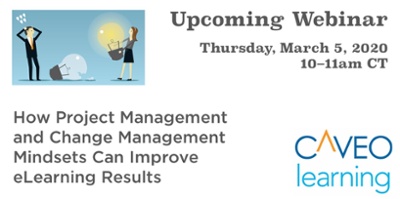Posted by Caveo Learning ● February 6, 2020
So You Want to Work in L&D...
 The learning and development (L&D) field is unique because people come into it from a variety of paths: working your way into it from a line of business, rotating into it as part of a management or human resources path, or seeking it as part of a career in education or leadership fields. However you come to be a new L&D professional, you have an opportunity to bring a fresh perspective to your team, and to develop your own approach to maximize an organization's investment in learning. Consider these ideas to start your career in L&D:
The learning and development (L&D) field is unique because people come into it from a variety of paths: working your way into it from a line of business, rotating into it as part of a management or human resources path, or seeking it as part of a career in education or leadership fields. However you come to be a new L&D professional, you have an opportunity to bring a fresh perspective to your team, and to develop your own approach to maximize an organization's investment in learning. Consider these ideas to start your career in L&D:
Find your audience
Matching the learning message to your audience(s) is essential in building effective courses, and many L&D teams serve a variety of audiences with different needs and commitments. For this reason, part of your early ramping up should include spending time getting to know all your audiences as well as possible. L&D departments are often kept under human resources or corporate management, away from the "front lines" of people doing the work, and this builds a tendency to be seen as disconnected from the workforce. Additionally, since most "training requests" come from corporate leadership, L&D tends to view leadership as their customer and build to those requests. To avoid this disconnect, get to know your actual audience by locating and talking to audience members on the front lines who are going to receive the L&D messages you're creating. Interview audience members at various levels: managers, their team members, team leads, new hires, long-time workers, business team leaders, and executives. Ask the same questions of each to hear their perspectives on the same topics such as learning priorities, where they find support, time available to complete development on the job, success stories, and how they put learning into action.
See the work in action
Once you've spent time getting to know your audiences, spend more time seeing the work. Some organizations ask their new training team members to shadow a front-line worker, but this should be a minimum standard for all L&D teams. While interviewing your audiences, ask them if you can spend a few hours or a few days watching them work to have a better idea of what they do and how they use learning on the job. By showing an openness to seeing the work, you're helping to break down the distance of L&D even further, and you will build a better relationship with that client. Have a plan for what you want to see when you observe, and ask questions if possible to see how they've used recent training initiatives in their daily work. Identify what they seem to know and do well, what obstacles they may have to achieving success, and what they want more of for their own learning and development. Also try to see how and where they would complete training so you know what may or may not be effective as you roll out new programs. By getting a better picture of the work completed by your audience, you can better speak for that audience when planning and designing new programs in a way that someone who's been working in L&D for years may not know.
Sample the buffet of programs
L&D programs today can exist in a wide variety of modalities and materials, from informal on-the-job training to large multi-day instructor-led sessions. Avoid assuming you know what type of training you will be creating, even if you were told at hiring, by absorbing the full breadth of all the materials currently in use throughout the organization.
You'll likely have learned during your interviews and shadowing that many learners have a perception that training only looks one way: eLearning, instructor-led training, PowerPoint decks sent around for reading, etc. Additionally, you may have your own background and biases of what you like, what you've seen, and how you've learned, which may influence you in your new position. You will be a better L&D professional by thinking outside your own biases and preferences and considering what's possible or what trends might work for your new audiences. Just because you were told at hire you would be developing eLearning doesn't mean that's all you might be doing in the long run; current trends in microlearning or video might mean you're supplementing your eLearning with other companion materials. By seeing what else is in use, you'll have a better vocabulary and toolbox as you start to plan your programs.
Plan your own development
Now that you've met new connections, assessed the landscape of the audience's needs, and absorbed what L&D materials look like at your new organization, it's time to build a plan for developing yourself, no matter what your path might be for this new role. How will you stay connected with these people? What do you need to learn in order to achieve success? What tools and skills do you need to develop? What networking opportunities will you pursue? Who knows more than you do, so you can learn from them? Answer these and other questions for yourself and then set a plan for how you will achieve your goals, keep yourself educated on what's new, and stay in touch with the business so you don't become distant yourself.
As an even better practice, plan to revisit some of these steps every year so you can see what's changed, and hopefully improved. Once you've spent a bit of time learning the training landscape in your new position and gauging how your clients learn and develop, you'll be ready to create and implement programs in a more informed and impactful way.
Topics: Instructional Design

